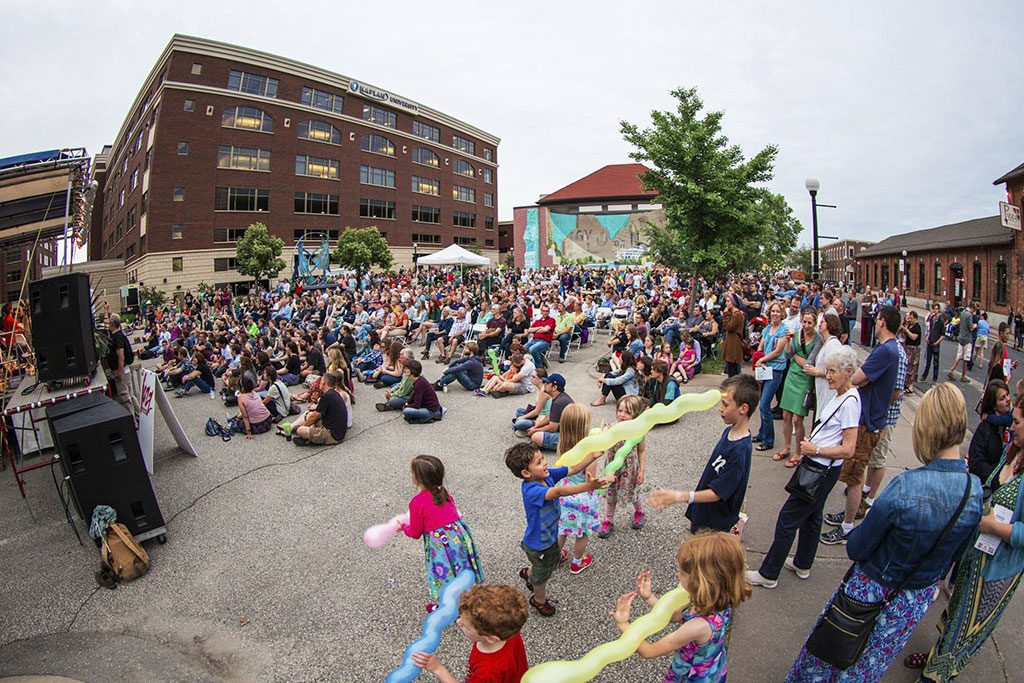
Designing outdoor spaces where people can rest or interact is essential in a dementia-friendly community.
In 1991, the Americans with Disabilities Act was passed, and one of the more visible and effective changes the law created was improving the physical layout of all new, and many existing buildings, removing physical barriers into and through buildings and streetscapes. On a smaller scale, and through a voluntary rather than mandatory process, many communities are working to make their buildings and streetscapes more navigable for people with dementia. In my first blog, I discussed ways that communities and businesses can become dementia-friendly when it comes to support, training and understanding. In this blog, I will highlight some of the ways that communities and businesses are making physical changes to become more dementia-friendly.
Main Street districts are a perfect area to implement these types of changes, since most have retail, restaurants, banks, post offices, pharmacies, etc.—business types that most older adults utilize frequently. Main Street districts also have well-defined spaces with wayfinding signage, crosswalks, benches, etc.
Studies have shown that many people with dementia especially struggle navigating around retail stores. Clear signage and/or different-colored or numbered aisles can alleviate disorientation. Customer service desks and checkout areas should be well-signed and easy to find as well. Clearly labeled exits and restrooms are also very important. Having family or unisex restroom options is ideal, so if a person needs assistance from a family member, it’s less embarrassing than in a standard restroom.
From a city planning perspective, Main Street districts can be ideal locations for housing for seniors or people with dementia. Typically, most of the things people need on a daily basis are within walking distance. There are also more people on the streets, so if someone does wander or gets lost, chances are someone will notice, and hopefully provide a helping hand or call for assistance. Main Street districts often have community gathering spaces, benches for short rests, traffic calming devices such as bumpouts and crosswalks, public transportation options and more. As Angela Lunde, a dementia education specialist at the Mayo Clinic, says, becoming dementia-friendly isn’t just about finding places to house patients, but also about making everyday spaces more inclusive.

This plan view of Hogeweyk in The Netherlands illustrates the many outdoor spaces within the secured facility, making it feel like a village instead of a nursing home.
There have been studies of the best way to design new memory care facilities. A few developers have implemented some radical designs, the first and most famous being the Hogeweyk dementia village in the Netherlands. This village replicates an indoor/outdoor residential and commercial neighborhood, but has only one exit, which is controlled.
It has a grocery store where no money is exchanged, but instead is just billed to their account. One controversial aspect is that the housing areas are differentiated by lifestyle types (class, religion, arts, culture), which puts only like-minded people together. Some have claimed it creates an alternate reality (as in the movie The Truman Show). But it also has outdoor streets, squares, gardens, gathering spaces, and even a restaurant, bar and theater, all contained within the enclosed complex.

At the Lantern in Ohio, most of the public spaces are inside, but designed to feel like outdoor village streets.
The Lantern in Chagrin Falls, Ohio, has incorporated a similar village-like concept, but instead of open-air streets, it is enclosed within a larger building. Individual-looking homes are located along a replicated (carpeted) street, with street lamps, café tables, barber shops, hardware stores and more. The exterior, however, looks like any standard senior living complex. The actual living units have natural light through regular windows, but there are a small number of controlled exits for the entire complex.
There are several examples of communities that have addressed dementia-friendly physical improvements. One of the most comprehensive is in Honolulu. Hawaii leads the nation in how long its residents are living, and by 2030, it is estimated that 24 percent of Honolulu’s population will be age 65 or older. The city joined AARP’s Network of Age-Friendly Communities in 2013, and is currently working on an age-friendly action plan that addresses housing, transportation, outdoor spaces, buildings, communications and social support, among other items.
The Alzheimer’s Society, based in London, has created a guide on becoming a dementia-friendly retailer, which can be downloaded from their website. The guide lists links to various resources such as a dementia-friendly environment checklist, a dementia-friendly self-audit, and dementia-friendly design principles.
The World Health Organization has a checklist of essential features of age-friendly cities that can be used by communities as a self-assessment tool. It addresses things like lighting, pavement, crosswalks, signage, public transportation, benches, housing, accessibility, events and activities, employment, communication and health care options.






